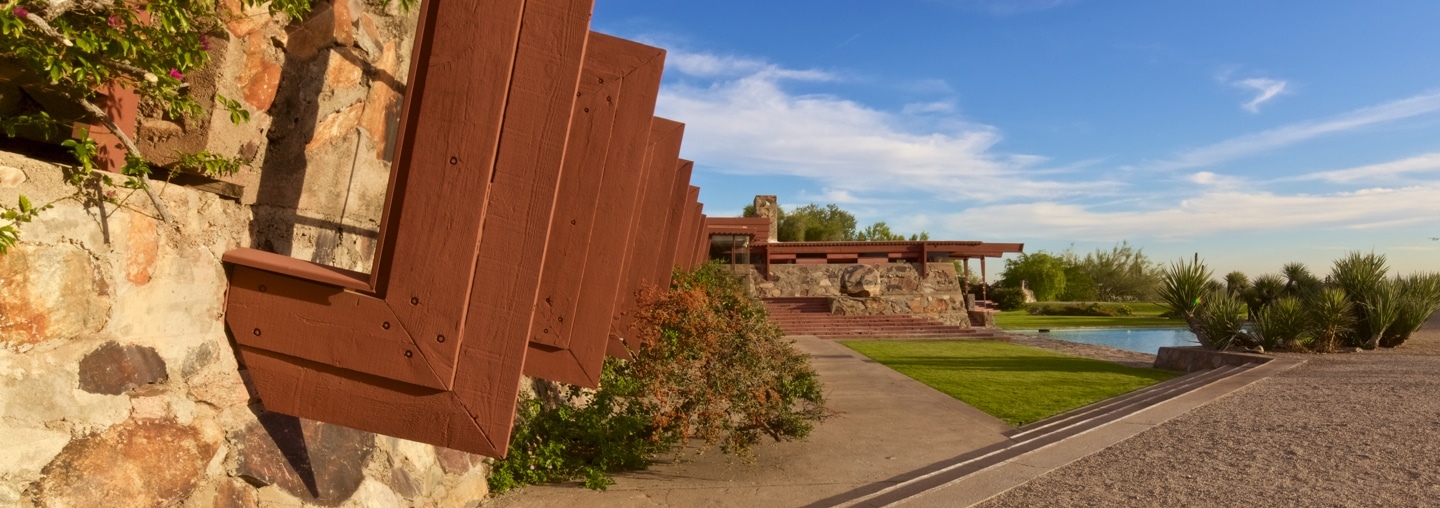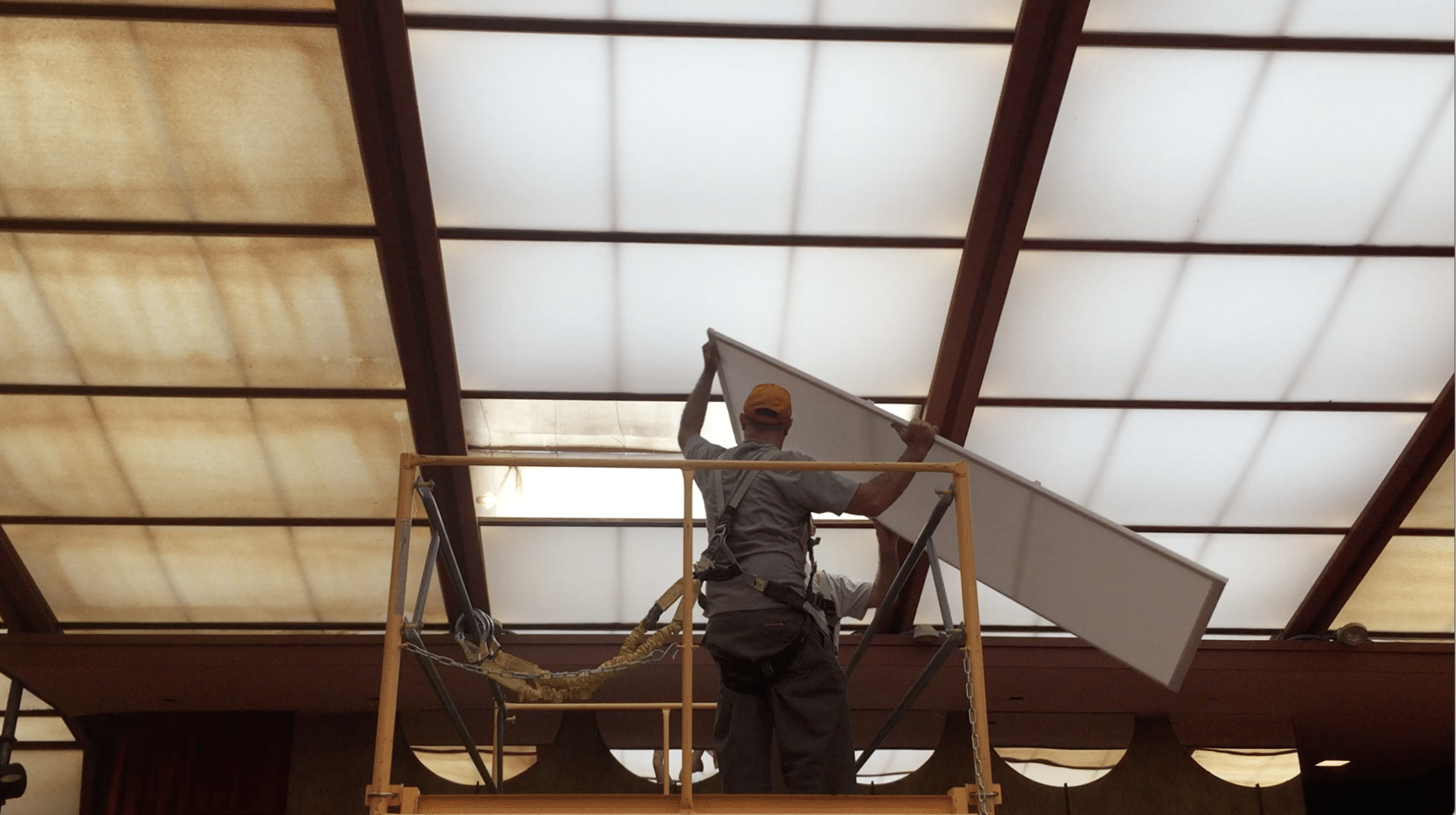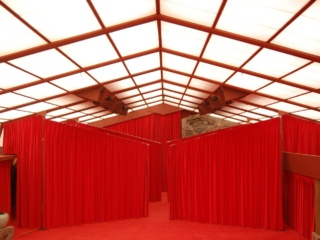
Living Architecture: Taking a Values-Based Approach to Historic Preservation
Frank Lloyd Wright Foundation | Feb 27, 2018
The Frank Lloyd Wright Foundation has taken a values-based approach to preservation efforts to ensure Wright’s home in the desert is accurately preserved and tells the story of his work and the life of the Taliesin Fellowship. As Taliesin West extends the legacy of innovation by showcasing unique design, sustainable practices, and education, the preservation team maintains a reverence for the history of the site. Fred Prozzillo, the Foundation’s Vice President of Preservation, explains how the innovative spirit of the National Historic Landmark in the Sonoran Desert is continuing as the preservation work evolves to fit the changing needs of the space.
What are some of the unique challenges you face with preservation projects at Taliesin West?
Fred Prozzillo: The preservation of Taliesin West is both unique and challenging. Often people think of historic preservation as picking a point in time and preserving a site to a specific date so people can study it, learn from it, and experience it as it was in that moment. Taliesin West was meant to be an ever-changing laboratory. Wright would come back to Arizona every year, after having spent the summer in Wisconsin, and would see the property with a new eye.

Fred Prozzillo

Installing the landscape lighting outside the Cabaret Theatre at Taliesin West.
For example, Wright was always experimenting with the translucent canvas roofs at the property. He would constantly change and test them to see if there were alternative solutions to the roofing system.
The challenge for the Foundation in thinking about how we preserve Taliesin West is: How do we work with this concept of constant change while fixing it in a specific period of time? The answer to this question will guide our decisions in our preservation work. The other challenge is that this property is a handmade, custom design that was constructed by young men and women who were learning about construction and architecture as they were creating it.
That poses interesting problems as we open up walls and find the really creative solutions they came up with for plumbing, electricity, or structure. They were all testing things and using the place as a laboratory for construction and design.
Does the preservation work ever challenge you to think about the different ways to use the space?
FP: Taliesin West is always changing. As an example, our administrative offices were built as apartments for senior apprentices. We’re always trying to utilize the spaces and adapt them to current needs. Everything that Wright did had a purpose, and we honor that in our approach to preservation. What use is just preserving this site if no one can live in it, occupy it, and experience it as intended? When we restore the spaces, it’s always with a programming end in mind. Our end goal is to really keep that spirit alive in the spaces and maintain that desert camp feel. Taliesin West is a living space that begs to be experienced by all those who visit.
Which preservation projects at Taliesin West have been the most important?
FP: There are two areas that always take priority. First is our infrastructure. Our water and electrical infrastructure is at the end of its serviceable life and we need to figure out how to replace it in a way that doesn’t compromise the buildings. Engineers of Stantec are assisting us in the planning and assessment of our current infrastructure. We want to make sure that when we replace water lines under the buildings, we don’t have to rip out the concrete floors.
We started asking if there is a way we can bore underneath the building and come up inside to preserve the historic concrete. Can we bore under the prow to preserve the landscaping, the walkways and the walls? For this, we’re partnering with an engineer at Arizona State University, Dr. Sam Ariaratnam, Ph.D, P.E., who is leading the horizontal boring technology, to see how we can do this here at Taliesin West to save the historic concrete and landscape. We can also apply this technique to our electrical systems to replace underground power lines in a way that is not harmful to the site.

Restoring Whitman Square at the entrance of Taliesin West.
The other priority is looking at our translucent roofs at Taliesin West; the roofs that used to be canvas and over time have changed to acrylic. We’re investigating a way to get back to a fabric roof material. With a grant from the National Endowment for the Arts (NEA), we’re researching different materials that could replace the acrylic and keep the buildings watertight. This may allow us to transition back to a roofing material that is more dynamic, alive and closer to what Wright used in his time.
We’re developing details to select a material that we’ll then test on a replica of a building we will install out in the desert. There, we’ll test different material selections under the sun, in the rain, and other elements. The result, we hope, will be the development of a material that’s not only suitable for installation at Taliesin West, but a widely-used sustainable building solution.
How is the Taliesin West facilities team different compared to other facilities teams?
FP: We have to be very conscious of how we touch the buildings. We want to preserve what we call the historic fabrics of the buildings, which are the materials that make up the buildings. Our goal is to preserve and work with them.
In non-historic construction, if a material deteriorates, it would simply be ripped out and replaced. We hold our materials to a higher value because this is a historic property. When our crew works on the property, they have to honor the legacy and history, which is why we’re dedicated to preserving as much of the original building as possible and not change its character.
We don’t want to have incremental change on the building. If we change small pieces over time, one day we might realize it isn’t Taliesin West anymore. We would have a building created by our facilities department, which is not what we are charged to do here.
We’re not here to change; we’re here to maintain and preserve. This sounds contrary to the idea of being an institution of innovation, but we see a profound challenge in finding creative solutions to keep the history intact. If there are any safety or structural changes that must be made, we make those contemporary changes by hiding it in the walls and not letting that change compromise the actual character of the building. At the same time, we are preserving the original structure so visitors can understand what was there and what the Fellowship originally built. The purpose is always to maintain that story and the life of the construction over time.

Replacing the fabric roofing in the Music Pavilion at Taliesin West.
It seems all of this preservation work in itself helps sustain the laboratory aspect of Taliesin West.
FP: As a National Historic Landmark, we’re trying to preserve what’s here so that we can tell the story of Wright’s time here, while still maintaining his legacy of innovation as modern technology evolves. For example, we’re trying to make Taliesin West a net-zero site, meaning we offset our energy consumption with the energy we generate, while preserving the historic integrity of the site. When we replace motors or equipment, we’re trying to replace it with sustainable, energy-efficient equipment.
We’ve created the Frank Lloyd Wright Innovation Studio to invite industry leaders to partner with us in this effort. We asked Osram Sylvania to come in and re-lamp the property with LED light bulbs to see if we can maintain that kind of incandescent lighting quality with LED. At night at Taliesin West, when the lights come on, the buildings glow like lanterns with the translucent roofs. It’s very low light, very much like a camp feel, as it was a camp. So the challenge to Osram Sylvania was how do we use this new technology–LED light bulbs–and still maintain that historic character?
In your preservation work, are you able to preserve the emotion Wright intended his spaces to have?
FP: Yes, we are taking a values-based approach to the preservation of Taliesin West. This means we aim to preserve important values that Wright may have held with the property. Looking at it today, we see he was dedicated to making the spaces feel like a desert campsite. We place value in certain aspects of the property like that. Sometimes those values align with our needs here and our programming of the property. Sometimes they might conflict, and that’s when we have to figure out the best solution to maintaining the historic character of the property while still telling the complete story of Wright and Taliesin West. We are still using the property as a laboratory, the way Wright had always intended it to be.
This article originally appeared in the Winter 2017 issue of the Frank Lloyd Wright Quarterly, “Taliesin West: The Desert Laboratory.”



